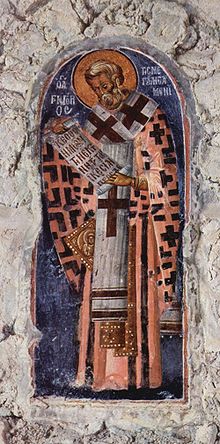Epigonation


The epigonation [ ˌepi | goˈnati | ɔn ] ( Greek ἐπιγονάτιον , literally "above the knee") or Paliza ( Russian палица , " club ") is a liturgical garment of Orthodox and Uniate Eastern Churches.
Appearance
The epigonation is a stiff, diamond-shaped cloth that is worn on the right side of the body below the hip. Mostly it is embroidered with icons . It is attached to a ribbon down from the left shoulder.
use
In the Eastern Orthodox and Uniate Churches of the Byzantine Rite , the epigonation is borne by all bishops. In addition, it can be given to a priest as a special honor. In the Greek tradition, it is a sign that the priest has a high academic degree and is entitled to receive confession through a special blessing . When a Russian priest is awarded both the Nabedrennik and the Palitsa , he wears the former on the left.
While the priest or bishop puts on the epigonation, he says the prayer: “Gird your sword around your waist, Mighty One, increase in your strength and beauty, flourish and rule because of truth, meekness and justice, and your rights will guide you wonderfully , now and forever, and into the ages of ages. Amen."
history
The origin is not fully documented. However, it is likely to go back to the decorated " tablion ", a thigh shield , which was given to military and civil officials of the Byzantine Empire . In church use it is supposed to represent a "sword of Christ" in the form of a weapon of the holy word. The second origin is the "Encheirion", an elaborately embroidered handkerchief, which got its current name and shape in the course of the 12th century. The former has no western counterpart, the latter would be comparable to the Manipel .
Individual evidence
- ↑ The Holy Liturgy ( page no longer available , search in web archives ) Info: The link was automatically marked as defective. Please check the link according to the instructions and then remove this notice. (PDF file)